What lurks beneath: Treasures, wrecks and curios
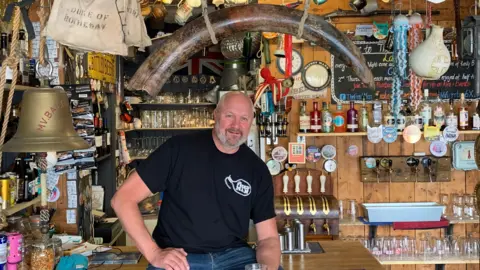 Ian Goodban
Ian Goodban Britain's coasts - once some of the most dangerous in the world to navigate for shipping - are littered with shipwrecks. This deadly legacy has left thousands of haunting artefacts and in some cases - lucrative treasure - resting on the sea floor. From time to time these relics re-emerge, found by divers on wrecks, walkers on beaches or they are mistakenly hauled up by fishermen or dredgers. A BBC Freedom of Information request has revealed the hundreds of fascinating items recovered in the last year alone.
A 200-year-old elephant tusk, coins from the Spanish Armada, plane parts, iron swords and a jar of Marmite were among the items found and reported to the Receiver of Wreck last year.
Human bones, mammoth bones and a French-made 2.5 tonne 17th Century bronze cannon were also on the list.
More than 300 items were declared in the 2023 report and with no details of the locations or finders shared with the BBC due to data laws, the task of tracking down the items was tricky and in some cases, impossible.
Some of the custodians of the items did not wish to share details of their finds but others like Ian Goodban, who stumbled across an elephant tusk on a beach were happy to share their stories.
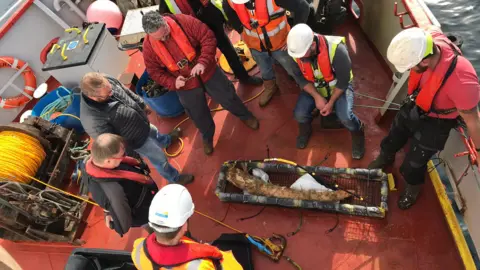 The SHIPS Project
The SHIPS ProjectIn the receiver's 2023 report the elephant tusk is listed as 3.5ft (1.1m) long and "blackened by mud".
Mr Goodban was beachcombing in Sandwich Bay, Kent when he "just saw something poking out the mud".
"I put my hand down... and I thought, 'I think I know what this is' and then the sand cracked in a big semi-circle and that's when I realised I had an elephant tusk," he said.
Mr Goodban said finding something that's lain undiscovered for many years was "always a real thrill".
"I was walking back to my car, had the tusk over my shoulder because of the curvature of the tusk, it sort of lends itself to being carried over the shoulder, and I... just thought to myself, 200 years ago there would have probably been an African porter walking out the interior with one of these on each shoulder, taking it down to the coast for export to England."
Surprisingly Mr Goodban's is not the only elephant tusk to have been found.
Another was found off Falmouth in 2019, 110m (361ft) underwater on a Royal African Company trader wreck.
The ship was believed to have been involved in the West Africa slave trade in the 1680s but sunk off Cornwall.
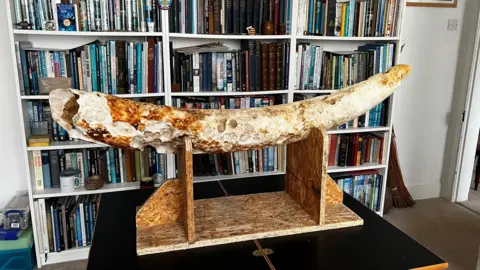
Untouchable treasure
The 350-year-old tusk is now in Plymouth in the care of Peter Holt, a director of the Ships Project, a non profit that researches and explores maritime historical sites.
He said: "It needs to go into a museum but because it is ivory and because it's been associated with the slave trade, finding a home for it has been difficult."
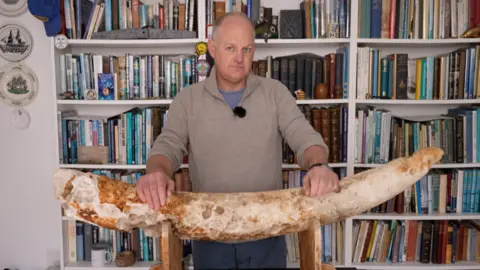
Partly eaten by wildlife, the tusk has spent much of its time above surface desalinating in fresh water.
"You have to get the salt out of them, if the object is allowed to dry, salt crystals will form on the inside and quite often the object will fall apart," Mr Holt added.
Other finds included ship's bells, crockery and ejector seat parts.
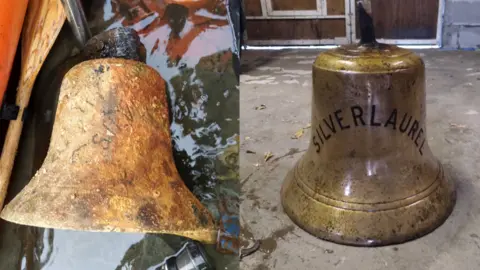 Dom Robinson
Dom RobinsonRecoveries at sea, within territorial waters, or up to the high tide water mark, have to be reported to the Receiver of Wreck within 28 days.
Finders who do not follow the rules can face a £2,500 fine or even court action.
Stephen White, the Receiver of Wreck, said he had one year to decide what happened to items.
"What we do is we negotiate between the owner and the finder for potentially a salvage fee," he said.
"About 85% of finders get to keep the items, but sometimes the items have extreme historical value and we try to find homes for them in museums."
Mr White said there was a backlog in dealing with reported items from the last few years due to understaffing and Covid.
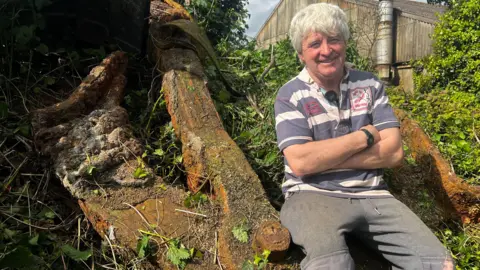
One of those waiting to hear an outcome is Brixham fisherman, Richard Fowler, whose boat, the Rebecca caught a two-tonne anchor in October 2021 while fishing off Lyme Bay.
"I’d like to know, I’d like to recover some of the money for the broken nets and storage but once I can pass it on I think it would look good in a pub," Mr Fowler said.
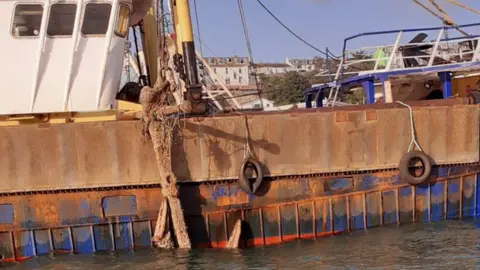 Richard Fowler
Richard FowlerOver the years fishing he said he had hauled up a whole cow, a sheep and a pre-prepared fish.
"We had a kipper in a bag once, complete with a knob of butter. The cow was dead, it was very wet, it had probably been washed down a river with heavy rain or dumped off the side of a ship carrying it.
"The sea is a mysterious place."
In the marine aggregate industry, where sand and gravel is brought up from the seabed, workers have been given training to identify culturally important items that end up in the dredged material.
Last year workers found mammoth bones, an American submarine badge and a bomb shackle.
 Wessex Archaeology
Wessex ArchaeologyAndrea Hamel, from Wessex Archaeology, who works as an adviser to the dredging industry, said: "We have had some really amazing finds dating back to the Middle Palaeolithic period.
"So everything from hand axes to mammoth teeth, it's just really incredible to be the first person to touch something in say 300,000 years.
"There's sometimes once-in-a-lifetime discoveries, we had a mammoth tooth discovered to us on the dredger and it was in almost pristine condition, it was a beautiful find."
 Wessex Archaeology
Wessex ArchaeologyThe University of Plymouth estimated there were 50,000 shipwrecks around the UK coast.
The law relating to marine salvage originally focussed on monetary value as shipwrecks could carry very rich cargoes.
It now also factors in historical importance.
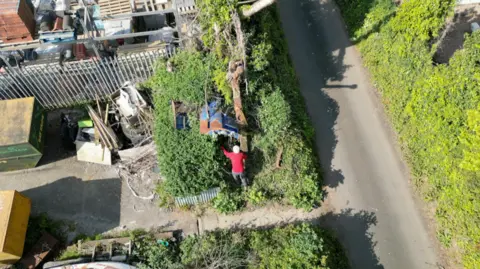
The area of Palaeolithic finds was off the coast of Norfolk, and in the case of the location of the mammoth tooth, a dredging exclusion zone has now been applied to protect the area.
"Around the South we get lots of different materials, around the Isle of Wight we get lots of aircraft or building debris, it looks like after the Second World War there were dumpsites of material being left on the seabed," Ms Hamel said.
"Around the UK it really does go back around one million years.
"It is incredibly exciting you never know what find will be reported next."
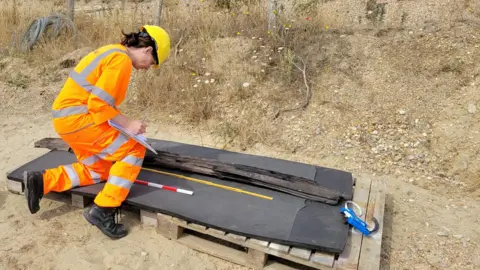 Andrea Hamel
Andrea HamelMr White added the reports to him included the weird and wonderful: "We have had beer vats, gas masks and on one occasion we had a jacuzzi that had fallen off a super yacht that had been reported to us.
"It's fascinating."
Treasure
But, he said, there were also items attracting a growing rise in professional treasure hunters.
"There are vessels out there with substantial amounts of gold, silver, copper ingots and each of those items have an owner," he said.
"We have found that with some of the historic shipwrecks we have had in the past, say the Gloucester or the Victory, those discussions with the owner, be it the Department for Transport or the Ministry of Defence, need to happen before anything is recovered."
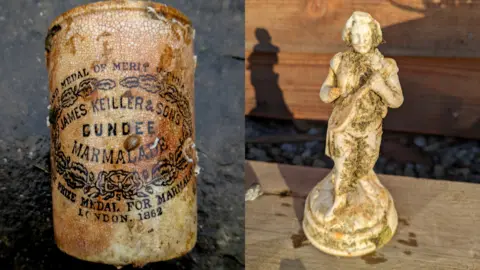 Dom Robinson
Dom RobinsonMany wrecks are now protected and the receiver said his team discouraged people from taking mementoes from wrecks - something that was subject to increasing debate within marine archaeology and wreck diving circles.
"A lot of the time the conservation costs in recovering things from the sea are expensive and lengthy, if you were to remove a cannon for example, that could be in conservation for 20 years," Mr White added.
Changing tides and the implications of trawlers and dredgers mean many wreck sites are beginning to disappear.
Protecting more wrecks is something another Ships Project director, Mallory Haas, backed.
She was part of the recovery team for the elephant tusk and said in the six months the team had been investigating the wrecked trade ship, it had been heavily disturbed by commercial fishing.
"The trawlers dragged cannons and tusks off the site area and now only a small portion of the wood from the vessel survives as the cannons were holding it down,” she said.
She added the site was one of the most important sites in UK waters because it helped "to explain England’s role in the transatlantic slave trade".
She said: "The site should be better protected and not allowed to be damaged by trawlers, which happens to so much of our underwater cultural heritage."
Follow BBC News South West on X (formerly Twitter), Facebook and Instagram. Send your story ideas to [email protected].
